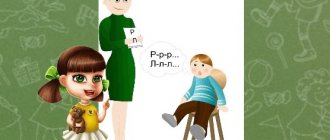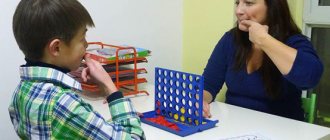The main activities of a speech therapist teacher
Nina Vasilyeva
The main activities of a speech therapist teacher
The main activities of a speech therapist teacher
The correctional work of a teacher-speech therapist in a preschool educational institution is aimed at overcoming speech and psychophysical disorders in children with severe speech disorders.
1. The main goals of the activity of a teacher-speech therapist
• Identification of children with speech disorders.
• Correction of speech disorders.
• Prevention of speech disorders in preschool children.
•Overcoming secondary manifestations of speech insufficiency: difficulties in communicating with the outside world often interfere with the correct formation of cognitive processes and affect the emotional-volitional sphere.
2. The main activities of a teacher-speech therapist
• Providing correctional assistance to children experiencing difficulties in speech development.
• Consulting teachers on issues related to children's speech development.
• Consulting parents on issues of children's speech development.
2.1 Corrective and developmental activities
Providing correctional assistance to children experiencing difficulties in speech development is carried out in correctional and developmental classes. Corrective and developmental individual, subgroup, group, and integrated classes in accordance with the Program are of a playful nature, are rich in a variety of games and developmental play exercises, and in no way duplicate school forms of education.
In frontal classes on the development of lexical and grammatical categories, work is carried out to expand and activate children's vocabulary with the names of objects, their parts, qualities, actions, and to correctly correlate the word with the image of the object. Generalizing concepts are introduced and clarified. The word-formation function of speech and inflection are formed and developed.
In subgroup classes on the development of coherent speech, children learn to compose various sentence models, retell and compose stories based on demonstrations of actions, a series of plot pictures, a plot picture, personal experience, descriptive and creative stories.
In classes on the sound culture of speech and preparation for learning to read and write, children learn to correctly pronounce the sound being studied, differentiate it by ear and in pronunciation, perform sound-letter analysis and synthesis of syllables and words.
In individual lessons with children the following is carried out:
• Breathing exercises (formation of a long, strong, smooth air stream for the correct pronunciation of sounds);
• Articulation gymnastics (various exercises to develop the muscles of the articulatory apparatus)
;
• Finger gymnastics (exercises and games to develop motor skills of the fingers)
;
• Correction of sound pronunciation in different ways;
• Automation of sounds in speech;
• Differentiation of sounds in speech;
• Enrichment of vocabulary;
• Consolidation of knowledge acquired by children in frontal and subgroup speech therapy classes.
In all of the above classes, motor skills, coordination, spatial orientation and constructive praxis are improved. Work is underway to develop speech skills and form relevant concepts. based on the formation of in-depth ideas and real knowledge of children about the world around them. The results of speech therapy work are noted in the child’s speech record at the time of graduation and are brought to the attention of the teacher, kindergarten administration and parents.
2.2 Consulting teachers on issues related to children’s speech development.
The speech therapist interacts with teachers in different forms. This is the joint preparation of long-term work planning for the current period in all educational areas; discussion and selection of forms, methods and techniques of correctional and developmental work; equipping a developing subject space in a group room; mutual attendance and participation in integrated educational activities ; joint implementation of educational activities during regime moments, weekly assignments of the speech therapist to educators. In the calendar plans of educators at the beginning of each month, the speech therapist indicates lexical topics for the month, an approximate vocabulary for each topic being studied, the main goals and objectives of correctional work; lists the names of children whose developmental correction educators should pay special attention to in the first place in a given period of time.
The speech therapist’s weekly assignments to the teacher include the following sections:
• five-minute speech therapy sessions;
• outdoor games and finger gymnastics;
• individual work;
• recommendations for the selection of fiction and illustrative material.
Speech therapy five-minute sessions serve for speech therapy of joint activities of the teacher with children and contain materials on the development of vocabulary, grammar, phonetics, coherent speech, exercises for consolidating or differentiating delivered sounds, developing skills in sound and syllabic analysis and synthesis, phonemic representations and non-speech mental functions, coherent speech and communication skills, that is, to repeat and consolidate material worked out with children by a speech therapist. Usually 2 - 3 five-minute lessons are planned per week, and they must be kept within the framework of the lexical topic being studied. The speech therapist not only gives recommendations on how to conduct five-minute sessions, but in some cases also provides materials and manuals for conducting them.
Outdoor games, exercises, and finger exercises serve to develop gross and fine motor skills, coordination of movements, coordination of speech with movement, development of imitation and creative abilities. They can be used by educators as physical education minutes in organized educational activities , outdoor games during a walk or in their free time in the afternoon. They are also necessarily kept within the framework of the lexical topic being studied. It is in games and play tasks that the child’s emotional attitude to the meaning of a word is most successfully revealed.
When planning individual work for teachers with children, the speech therapist recommends that they conduct classes with two or three children per day in those sections of the program in which these children have the greatest difficulty mastering. It is important that during the week each child works with teachers individually at least once. First of all, speech therapists recommend individual work on automation and differentiation of sounds.
Knowing what difficulties educators experience when selecting visual, didactic and literary materials, and how difficult it is for them to take into account the characteristics of the general and speech development of children with speech pathology, the speech therapist teacher, as a rule , draws up an approximate list of fiction and illustrative material recommended for each week of work.
The music director helps in the correction of speech disorders by using:
• musical and rhythmic games;
• exercises for the development of auditory perception, motor memory;
• sketches for the development of expressive facial expressions and gestures;
• dramatization games;
• speech therapy chants.
When working with specialists, the speech therapist teacher keeps interaction notebooks in which they record recommendations and tasks for working with children.
2.3. Consulting parents on the development of children's speech.
The teacher special attention to advisory work with parents on the problems of teaching and raising children with speech disorders. It is carried out in the form of parent meetings, individual and group consultations, conversations, round tables, seminars, and open classes. Speech therapy stands for parents with replaceable materials are widely used.
The main areas of advisory and educational work of a speech therapist with parents are:
• Formation of positive motivation to interact with the teacher, increased interest in classes on the development and correction of speech, preparing children for learning to read and write, and correction of written speech disorders.
• Developing an adequate attitude to the peculiarities of children's speech activity .
• Formation (promotion)
competence in matters of speech development
(ontogenesis)
of children of different age groups and speech disorders
(expressive and impressive speech, writing and reading)
.
• Training in basic techniques of correctional and developmental work (articulatory gymnastics, some types of speech therapy games, basic rules (algorithms)
completing written assignments).
• Familiarization with various types of teaching aids and literature on organizing and conducting developmental classes at home.
3. Methodological activity
The methodological activities of a speech therapist at a preschool educational institution include:
• development of methodological recommendations for speech therapists, educators and parents on providing speech therapy assistance to children;
• long-term planning;
• study and generalization of best practices;
• participation in the work of methodological associations of speech therapists ;
• searching for the best means of correcting children's speech;
• study and implementation of variable forms of providing correctional assistance;
• self-education;
• production and acquisition of visual and didactic material on the development and correction of speech.
4. Analytical activities
Analytical work allows the speech therapist to track the effectiveness of the ongoing correctional and developmental activities , i.e., highlight all possible positive and negative aspects of this activity , and also track the dynamics of the development of each child. It includes:
• Carrying out control sections.
• Conclusion of the PMPC on the issue of releasing children.
• Graduation interviews (final events)
.
• Summing up the work for the academic year.
• Report – analysis of the work done by the speech therapist teacher .
Forms of speech therapy classes
The following forms of speech therapy classes are distinguished:
- Individual sessions.
- Frontal exercises.
Individual lessons are aimed at developing children’s articulation organs, correcting sound pronunciation and working with one or another defect in pronunciation or perception of sounds, due to the specifics of speech pathology and the general mental state of the body.
Individual work has its advantages. They are due to the fact that the work is carried out one on one between the speech therapist and the child. This allows us to apply an individual approach to correctional therapy, taking into account the interests and needs of each child and his developmental characteristics.
In individual lessons, the child’s base for further production of sounds is formed, the organs of articulation are prepared for work, phonemic perception skills are formed and the pronunciation of problematic sounds is established. Also, work is being done to develop the motor functions of the child’s body. It is necessary to automate the delivered sounds.
Finished works on a similar topic
Course work Speech therapy work: directions and implementation with different age groups 480 ₽ Abstract Speech therapy work: directions and implementation with different age groups 230 ₽ Test work Speech therapy work: directions and implementation with different age groups 240 ₽
Receive completed work or specialist advice on your educational project Find out the cost
Individual work on developing the foundations of children’s auditory perception and the formation of their speech-motor skills is carried out in two stages:
- Preparing for correction. It is focused on creating the foundation for the child’s assimilation of the rhythmic structure of words in the language. Verbal and non-verbal material is used.
- Corrective work. It is carried out after the foundation has been created and is aimed at eliminating a particular speech defect. The production of syllables and sounds is adjusted for each individual child. The methods and means used depend on its individual characteristics.
As for frontal speech therapy classes, they require special organization. The following requirements apply to their implementation:
- Dynamic course of the lesson.
- A game form of work in the classroom.
- Including surprise moments in the course of the lesson with the participation of children.
- Variability of activities in the lesson and its frequent change.
- Communicative orientation of the lesson. The communicative development of all team members, the involvement of each child in work and the formation of the foundations of communication are expected.
- Variability, brightness and richness of didactic material used in the classroom.
- Accustoming children to listen to their own speech and the speech of other children with the correction of errors in pronunciation.
- The use of technologies and work methods in the classroom in an increasing manner, i.e. starting with simple ones and gradually making them more complex.
- A large amount of spoken language in class.
Frontal forms of speech therapy work are applicable for the correction of various speech defects, as well as expanding the child’s lexical vocabulary, forming coherent speech and laying the foundations of grammar, phonetics and spelling.
Areas of speech therapy work with preschool children
Speech therapy work with preschool children is implemented in the following areas:
- Formation of the foundations of phonemic perception and development of the auditory side of speech.
- Clarification of the correct audio pronunciation. Work is being done on the sounds that are present in the child’s speech.
- Differentiation of sounds. The pronunciation of sounds in different positions of the word is staged and they are brought to automatism.
- Consolidating methods for correct and clear sound reproduction of words of different composition.
- Development and improvement of the lexical and grammatical foundations of speech structure.
- Exercises to develop articulation organs and fine motor skills.
- The development of non-speech mental processes - attention, memory, perception, thinking, which are closely related to the child’s speech.
- Expanding ideas about the world around us as a basis for expanding a child’s vocabulary.




